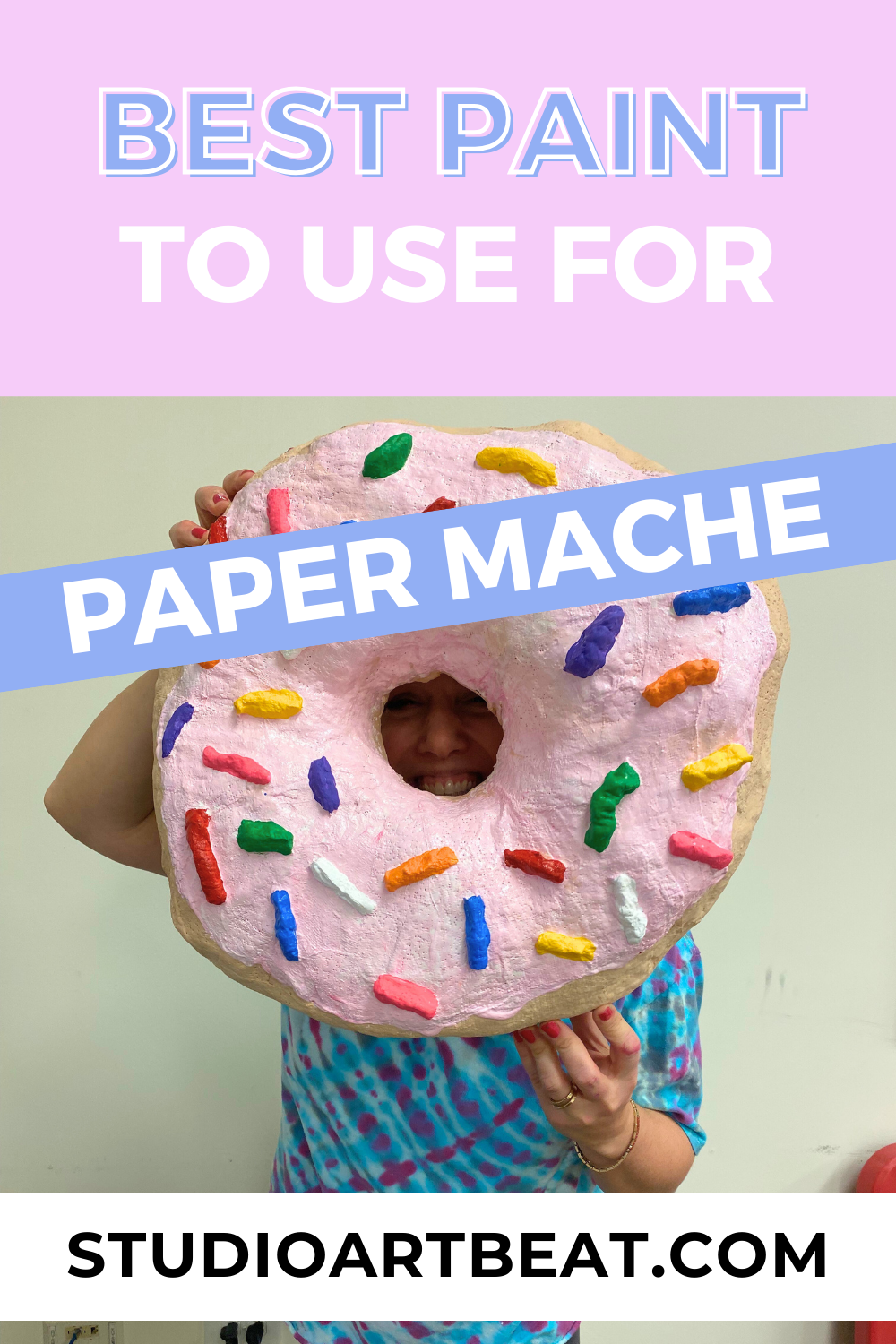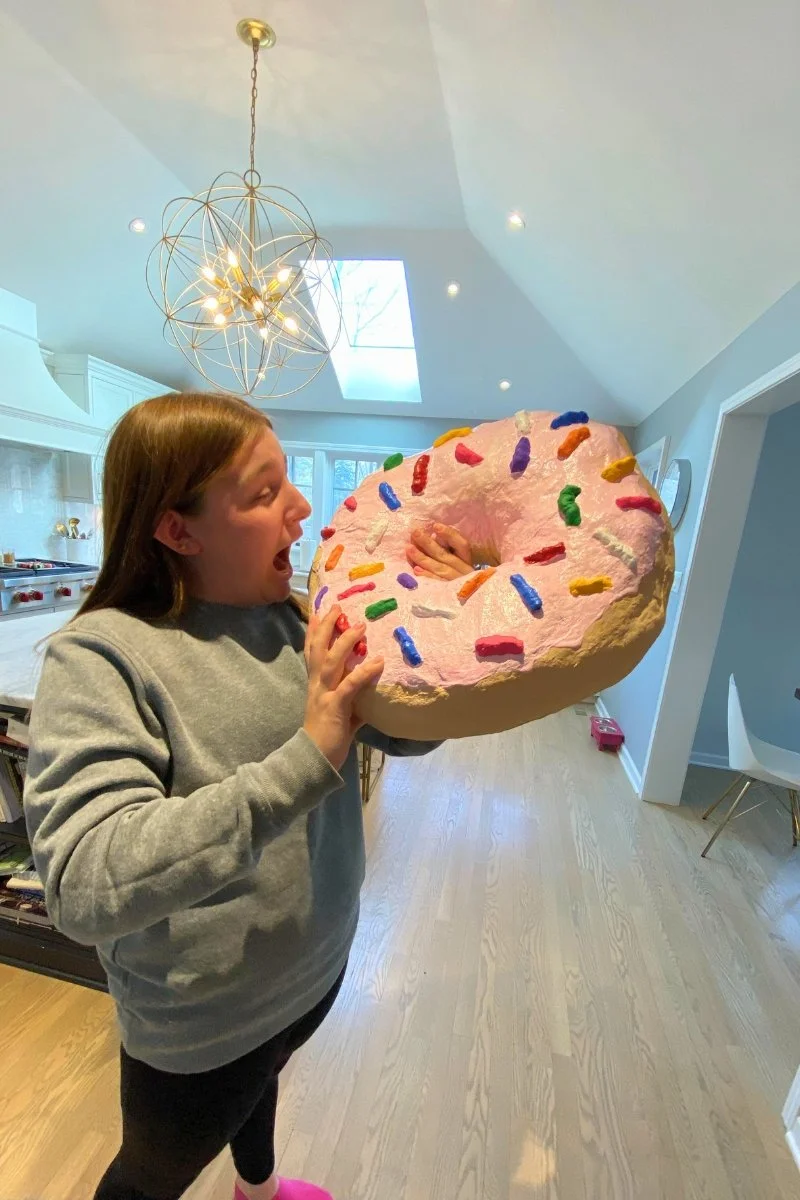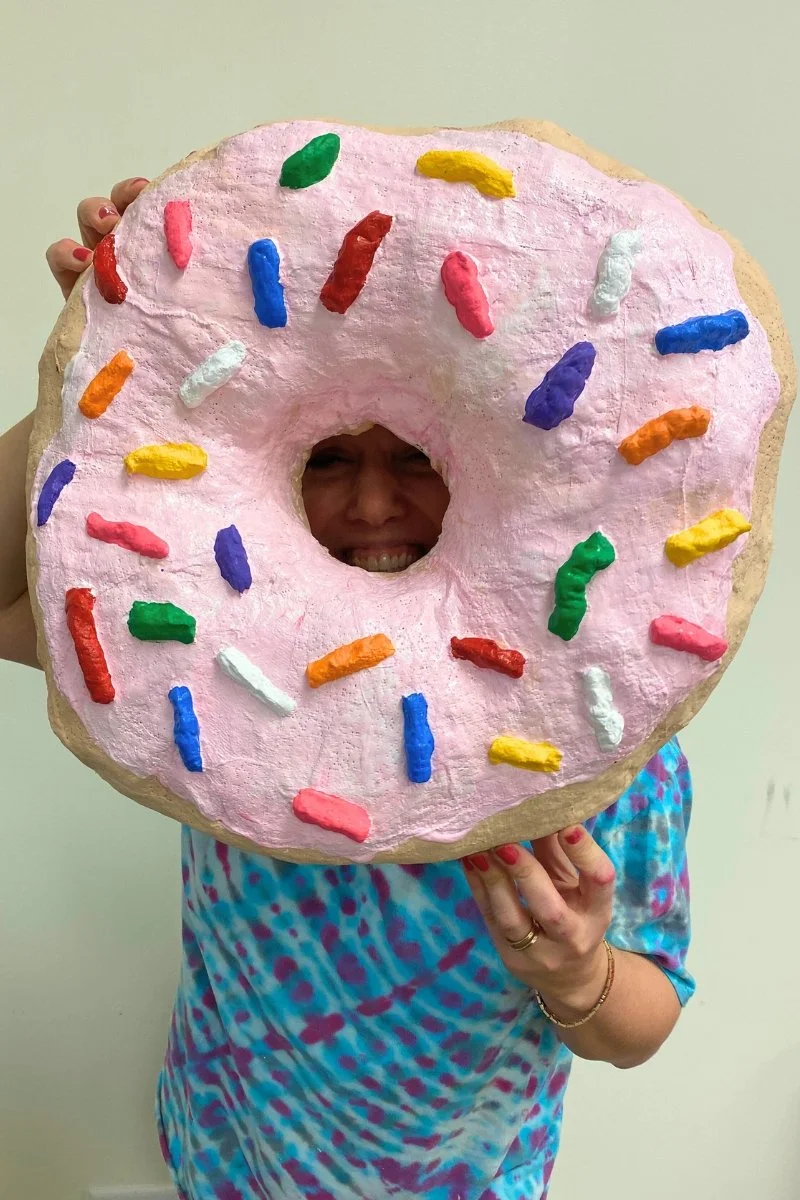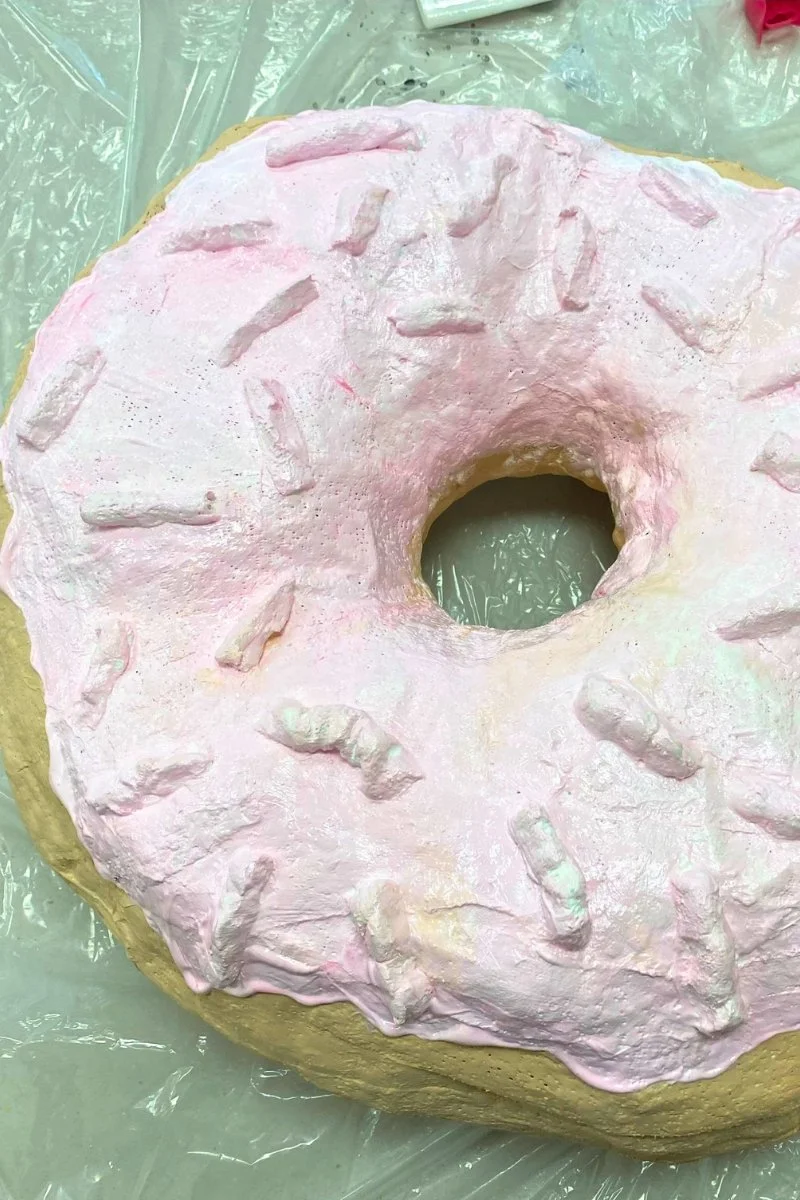What Is The Best Paint To Use On Paper Maché?
Last month the kids in my art class asked if they could do a paper maché art project. I loved making paper maché as a kid and I knew this would be a fun one!
The project at hand? Giant food. The result? Amazing!
We learned a lot during the process and I wanted to share what I learned after working on this for 4 weeks. The biggest question the students had was about the paint.
Giant paper mache donut
The best type of paint to use for paper mache depends on several factors, including the desired finish, durability, and whether the paper mache object will be used indoors or outdoors.
Newsflash: I do not recommend storing any paper maché project outside. But let's break down the paper maché process.
While this article will focus mainly on the painting process, the paper maché process takes a long time to complete starting with the paper strips, the white glue, paper mache clay, or however you choose to make your art. But once your project is finished, how do you add a finish to papier-mâché products?
What is Paper Mache?
Paper mache, derived from French terms meaning "chewed paper," involves a mixture of paper pieces or pulp combined with adhesive materials like glue or paste. This material is widely used in arts and crafts for its moldability and affordability.
Most art teachers have a love/hate relationship with paper mache because it is easy and does not have a fast drying time. Sometimes the use of flour, water, glue, and old newspapers can get moldy if students do not use an even layer of soft paper during application.
Plus, in my experience, kids love it because they can successfully make fantastic art using household items like toilet paper rolls, recycled newspapers, and trash. Yes, trash!
The donut pictured below was made with old grocery store bags. Kids often come up with the most creative ideas, but adults love making paper mache, too.
And if a mess isn't your thing, you can purchase paper mache boxes at the art supply store and simply paint and finish them. The largest online craft stores now have tons of ready-to-paint paper mache products (like animal heads and vases) if ripping thousands of strips of paper just isn't your thing.
Typically, paper mache projects start with a base structure formed using layers of paper and adhesive, which is then allowed to dry and harden. Ok, so let's break down the paint dilemma:
How to Paint a Paper Maché Project
My favorite paper mache project!
Paper mache, being porous, absorbs paint differently than solid surfaces. The paint needs to adhere well without causing the paper to warp or lose its structural integrity.
First layer of paint:
Apply a thick layer of white gesso
In my experience, adding a thick layer of white gesso is the best way to create a base coat to prevent the work area from absorbing and subsequently wasting paint. If you do not have white gesso, you can also add PVA glue to white paint to create a good base layer. Mod Podge works nicely, too.
just do not paint directly onto papier mache without creating this important barrier layer. If you do not require your paper mache project to be strong or you want to highlight the fragile and absorbent nature of paper, you can use any paint: poster paint, tempera paints, or even watercolor.
Watercolours will seep right into the paper, but will have more of a delicate, ethereal look to it). However, I prefer my paper maché to be strong so I always do a gesso layer first. Think of this as the primer.
Second layer of paint:
Apply a second layer of paint
Once you have applied the gesso layer and allowed it to dry, you can begin painting in bright colors or light colors depending on your preference. If you've truly primed your artwork, you can pretty much use any kind of paint. My preference is acrylic because it is easy.
However, if you are working on a large scale piece or creating paper maché with a full class, you might want to consider using household paint which can be purchased at any hardware store. You can also apply the best-quality spray paint like Montana Golden or interior paint. Using house paint adds a layer of extra protection and a smoother finish.
Final layer of paint:
Papier-mâché sculptures will often have a final layer of detail using light coats of paint or incorporating more than one color to your surface. This is also the time to add details. Depending on the desired effect, artists may prefer paints that offer matte, glossy, or textured finishes.
Apply a final layer of paint in the finish of your choice
The paint choice can affect how light reflects off the surface, adding depth and character to the artwork. When adding texture and finish, you can use a variety of paints such as acrylic spray paint, poster paint, or paint pens for extra detail. I also love to put paint onto a plate or palette and apply it with a damp sponge.
This is a great way to add texture or a little bit of color or shine to your second coat of paint. One of the easiest ways to add detail to your paper mache creation is by using acrylic or oil-based paint pens.
Adding details:
You can add details like googly eyes, pipe cleaners, or any object to your papier-mâché sculpture. In my experience, using a hot glue gun is the best choice for speed and durability.
Adding a finish for durability:
Especially for projects intended for display or handling, durability is crucial. Paints that resist cracking, peeling, and fading ensure that the artwork remains intact over time. It is best to add a finish to your piece. You can use Mod Podge, shellac, or really any finish. Your finish can be high gloss or matte, but you will want to seal the artwork.
For best results when working with kids or a large class, I've developed an easy tip. Mix a cup of water with a cup of Mod Podge or white glue. Mix well and add to individual spray bottles. Have the kids spray on their final finish.
Types of Paints Suitable for Paper Mache
1. Acrylic Paints
Acrylic paints are a popular choice for paper mache due to their versatility, vibrant colors, and ease of use. They adhere well to porous surfaces and dry quickly, allowing artists to build up layers and achieve desired effects efficiently.
Available in matte, satin, and glossy finishes, acrylic paints offer flexibility in creating different textures and visual effects. They are also water-based, making cleanup easy and safe.
2. Tempera Paints
Tempera paints, often used in schools and children's art projects, are another suitable option for paper mache. These paints are water-based and non-toxic, making them safe for all ages. They provide excellent coverage and vibrant colors, although they may not be as durable as acrylic paints without a protective sealant.
Tempera paints are available in liquid form or as solid cakes that can be mixed with water for painting.
3. Spray Paints
For larger paper mache projects or those requiring a smooth, even finish, spray paints can be an efficient choice. Spray paints adhere well to paper mache surfaces and provide quick coverage without brush strokes. They come in a wide range of colors and finishes, including matte, satin, and metallic.
However, spray paints should be used in a well-ventilated area due to their fumes and may require additional protective coatings for durability.
4. Watercolor Paints
Watercolor paints offer a unique transparency and blending capability that can create subtle washes and gradients on paper mache surfaces. They are ideal for projects where a more delicate or artistic finish is desired, such as decorative items or small sculptures.
Watercolor paints work best on less textured surfaces and can be sealed with a fixative to protect the artwork.
5. Varnish or Sealant
Regardless of the type of paint used, applying a varnish or sealant to finished paper mache projects is recommended to protect the surface from moisture, dust, and UV damage.
Varnishes come in matte, satin, and glossy finishes and can enhance the colors while providing a durable protective layer. Water-based varnishes are preferred for easy application and cleanup.
What is the best paint to use on Paper Maché?
The best way to paint for paper maché is to use one layer of white gesso followed by layers of acrylic paint. Details can be added using waterproof marker pens or paint pens once each layer is dry.
Application Techniques
The choice of paint also influences the techniques artists can employ to achieve the desired effects on paper mache:
Brush Techniques: Using brushes allows for detailed painting, blending colors, and creating textures such as stippling or dry brushing.
Sponge and Dabbing Techniques: Sponges can be used to apply paint in a dabbing motion, creating textured effects or a stippled appearance. You can use either a wet sponge or a dry sponge. Simply put the paint onto a paper plate and apply by dabbing.
Spraying Techniques: Spray paints enable even coverage and can be used to achieve smooth gradients or solid colors without brush marks.
Mixing Media: Artists often combine different paints or mediums such as acrylics with watercolors for mixed-media effects that enhance the visual interest of paper mache artworks.
Considerations for Specific Projects
1. Masks and Costumes
For theatrical masks or costume pieces made from paper mache, durability, and flexibility are crucial. Acrylic paints or spray paints provide the necessary coverage and resilience to withstand handling and occasional wear.
2. Decorative Objects
Decorative items such as bowls, vases, or figurines benefit from paints that offer a decorative finish, such as metallic or pearlized acrylic paints. These paints can enhance the aesthetic appeal of the artwork and complement different interior styles.
3. Outdoor Art Installations
If the paper mache artwork will be displayed outdoors, paints with UV protection and weather resistance are essential. Acrylic paints formulated for outdoor use or sealed with a weather-resistant varnish can prolong the artwork's lifespan and maintain its appearance despite exposure to elements.
How long do paper mache projects typically take to finish?
Paper mache projects require several hours of work. Between adding layers of newspaper or paper, letting the whole thing dry, several painting sessions, and then adding a finish, this is not a quick project and requires planning, patience, and a tolerance for mess.
So, what’s the best paint to use on Paper Maché?
Choosing the best paint for paper mache involves balancing artistic preferences with practical considerations such as adhesion, durability, and safety. Acrylic paints are widely favored for their versatility and durability, making them suitable for a wide range of paper mache projects.
Tempera paints offer vibrant colors and are safe for children's use, while spray paints provide quick coverage and a smooth finish. Watercolor paints allow for artistic effects and delicate detailing, while varnishes or sealants protect the finished artwork and enhance its longevity.
Ultimately, the best paint for your paper mache project depends on your artistic vision, the intended use of the artwork, and the desired aesthetic and functional qualities.
By selecting the right paint and applying it with appropriate techniques, you can bring your paper mache creations to life with color, texture, and lasting beauty.
Have more questions about paint? Check out my acrylic paint guide for artists!






